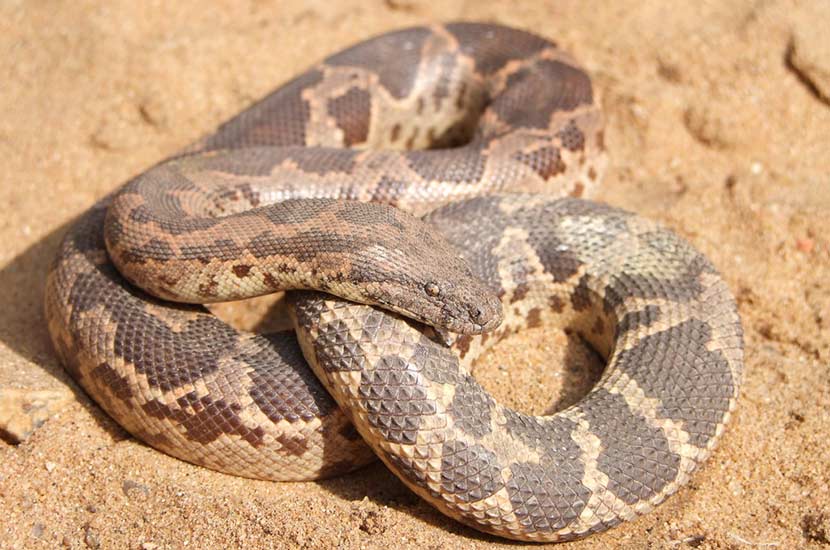Erica Mede, CVT
Description
This docile, slow moving, stout bodied snake reaches lengths of 2-3 feet and live for 15-20 years in captivity although longer has been documented. Sand boas are rarely bite, preferring to ball up or escape rather than attack. With a stout body and blunt tail this snake makes a great pet and is popular in the pet trade due to the morphs (colors and patterns) that can be created through selective breeding. There are 15 different species of Sand boa with several being well represented in the pet industry. These snakes have small eyes and heads that are ill defined against their body. By two years of age, females of the species will be significantly larger than males.
Natural History
Sand boas are found throughout south and south east Europe , Asia Minor , Africa , Arabia , central and southwestern Asia , India , Sri Lanka , western United States and northern Mexico depending on the species. These snakes are exceptional at burrowing and in captivity can be found with just their heads sticking out of the substrate. These nocturnal snakes are found in dry areas with only partially sandy soil not sand alone.
Sexing
Females are generally longer than the males by two years of age. Probing is an excellent way to determine gender but should be done by a confident snake keeper or veterinarian as damage to the snake can occur.
Enclosure
There are many different ways to keep Sand boas, as with any snake. A 10-20 gallon tank is a good size to keep this snake in. The larger the enclosure the better. Custom enclosures can be made and sweater boxes can be utilized as well and seem to work exceptionally well in this species as the opacity of the walls offers a more secure feeling. Floor space is much more important than vertical space in this species, strive to offer the most. Ventilation is important. Plastic enclosures such as sweater boxes can have ventilation holes created using a soldering iron or a drill. Vision cages are an excellent option but the substrate depth is rather limited due to front sliding doors.
Substrate
Sand boas prefer to burrow in their substrate, especially during the day light hours. If newspaper, paper towel, or reptile carpet is being used it is recommended to shred newspaper on top to promote burrowing behavior and to prevent undue stress on the animal. Aspen can also be used as long as the aspen is agitated daily and bedding is changed weekly. The aspen must be kept around 2-4 inches deep to offer the appropriate burrowing behavior. Never use pine or cedar shavings as the aromatic oils are irritating to snakes. Although these snakes are called “sand” boas, they are not native to all sand terrains. Sand boas will burrow in sand but the risks are greater than the advantages including impaction from ingestion and abrasions from inappropriately sized sand particles. If a naturalistic set-up is to be created, a 60-70% top soil to 40-30% play sand mixture should be utilized and monitored carefully.
Temperature and Humidity
The enclosure, regardless of type, should have a gradient of 75-85F° with the warmest spot no more than 90F°. These temperatures should be maintained with a thermostat and monitored with two thermometers ideally. One thermometer should be placed on the warm end an inch above the substrate and the other an inch above the substrate on the cool end of the enclosure. Under tank heaters, heat cable (outside the enclosure not in the enclosure), heat tape are the most appropriate to warm the substrate.
Humidity should be maintained under 50% to keep this species healthy as they do poorly in high humidity. No special techniques are needed to keep the humidity low, just proper ventilation and placement of the water bowl on the cool side of the enclosure.
Accessories
Cage accessories should consist of two hide boxes with one on the warm side and one on the cooler side of the enclosure if burrowing substrate is not provided. Hides can be as simple as a half a flower pot, half log, or as complicated as a rock structure (make sure it’s well anchored). Rocks added into the enclosure offers enrichment and some variation in the enclosure.
Lighting
Sand boas are nocturnal by nature and do not require intense lighting despite their desert habitats. However, it is recommended that a 5.0 ReptiSun UVB bulb be offered during the day light portion of the light cycle. All snakes can absorb the calcium from their whole prey for their own use but a UVB bulb still offers some health benefits as well as promotion of natural behaviors from the UVA being emitted.
Feeding
In the wild, these snakes feed primarily on rodents, lizards, and small birds that pass by. In captivity however, most are fed mice with a penchant for smaller rodent prey than what their size could ingest. These snakes seem to relish nestling mice the most and feed well after dusk! It is highly recommended to feed only pre-killed prey as live prey can severely injure or kill a snake. Chicago Exotics recommends feeding properly thawed frozen rodents.
These snakes are aggressive feeders despite their slow moving nature. Hatchlings are typically fed pinkies or in the cases of the smaller species, pinky mice parts. Adults can eat small mice but tend to prefer hopper mice. Hatchlings should be fed every 5-7 days and adults fed every 7-10 days small meals.
Sources and Recommended Reading
Boas: Rosy and Ground, Jerry Walls
The Art of Keeping Snakes, Philippe De Vosjoli
Boas, Doug Wagner
The New Encyclopedia of Snakes, Christopher Mattison
Living Snakes of the World, John M. Merirtens
Rosy, Rubber, and Sand Boas, R.D. Bartlett
An educational handout concerning reptiles and Salmonella is available through the Association of Reptilian and Amphibian Veterinarians. Please ask your veterinarian for a copy.
If you have any questions, please feel free to call us at (502) 241-4117.

